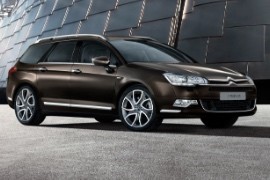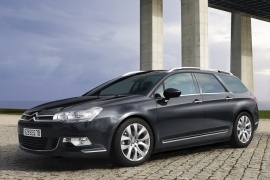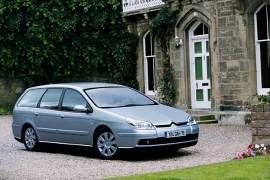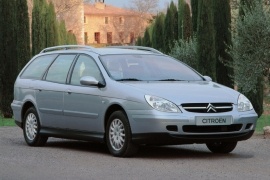CITROEN C5 Estate Models/Series Timeline, Specifications & Photos
First production year: 2001
Engines: Diesel, Gasoline
Body style: Wagon (station wagon, estate, combi, touring)
Citroen had a long history in building station-wagons long before its competitors started to draw their first ones. Its experience was proved once again with the 2010 C5 Tourer.
The marvelous Citroen DS was offered as a station-wagon since the late '50s, and the French carmaker continued to build such practical cars ever since. The C5 Estate (or Break) benefited from all that experience. The French brand introduced the second generation of that model in 2007 and, four years later, it enhanced it with a facelifted model.
There was a new L-shaped LED strip for the daytime running lights on top of the front bumper at the front. The headlights were reshaped accordingly, featuring a straight lower line instead of the older version, with a slight interior step. The reversing lights from the taillights received clear lenses.
Inside, there were just two buttons added, for the Citroen eTouch emergency system, in selected countries. That comprised a sim-card and a GPS module accessible via an SOS button for emergencies or a "double-chevron" button for other requests. The best part of the C5 Tourer was the rear adaptive suspension, available as an option. It could raise or lower the back of the car to ease-up loading and unloading. The same system was used to keep the car at the same level, regardless of the large trunk's added load.
For the 2011 model, the French carmaker offered the C5 Estate with a choice of gasoline and diesel engines, all turbocharged. The car was available with a 5- or 6-speed manual transmission, while a 6-speed automatic was available on selected versions.
In 2008, Citroen introduced the second generation of the C5 lineup, and that included the station wagon version as well.
Despite the warnings regarding the world financial crisis, the French carmaker risked introducing the second generation C5. It knew that the older model's sales were decreasing. The C5 had to compete against other European mid-size strong contenders such as the Passat, the Mondeo, and the Renault Laguna.
The second generation of the C5 Estate was unveiled simultaneously with its sedan sibling, and it showed a fresh design language. At the front, the slim headlights flanked the grille that sported a chromed slat with the "Double-chevron" Citroen badge in the middle. Unlike its predecessor, which relied on curved panels, the 2008 C5 Estate featured flatter surfaces and a hood crossed by two longitudinal powerdomes. On its sides, the long window line connected the A to the D-pillars with a chromed slat that adorned the door panels. The C-pillar sported a blacked area. At the back, the racked-forward tailgate offered the impression of dynamism, even though it was a family station wagon. It was 5 cm (2 inches) longer than its sedan sibling.
The cabin was roomy for five adults, with two bucket seats at the front and a split-folding rear bench. Its driver had a difficult time with the buttons spread on the center stack and the steering wheel. They were just too many. Its trunk offered 505 liters (15.5 cu-ft) of space, which was less than its main competitors had to offer. By folding the rear seats, the trunk was enlarged to 1,462 liters (51.6 cu-ft).
Under the hood, the carmaker offered the C5 a wide engine choice, enhanced and enlarged later on for the 2011 and 2012 facelifts.
CITROEN C5 Tourer 1.6L e-HDi 6AT FWD (115 HP)
CITROEN C5 Tourer 1.6L HDi 5MT FWD (115 HP)
CITROEN C5 Tourer 1.6L HDiF 5MT FWD (110 HP)
CITROEN C5 Tourer 2.0L HDI 6AT FWD (160 HP)
CITROEN C5 Tourer 2.0L HDi 6MT FWD (160 HP)
CITROEN C5 Tourer 2.0L HDiF 6MT FWD (138 HP)
CITROEN C5 Tourer 2.2 HDiF 6MT FWD (170 HP)
Starting with 2005, Europe was ready to switch to the Euro4 Emission Standards, and Citroen didn't want to wait and improved the C5 range, after just a few years since it launched it, and applied the transformations on the station wagon version as well.
Citroen replaced the Xantia and the XM lineups with the C5 in 2001 and, by 20004, it had already gained a presence on the market with its two bodywork versions: the sedan and the station wagon named "Estate." While the former was more of a liftback, the latter came with a traditional two-box wagon shape.
Starting with the first facelifted version, the C5 Estate featured a new styling, with boomerang-shaped headlights, with the outer sides swept back towards the fenders. The grille was also smaller, sporting a chromed slat on the upper side that comprised a part of the Citroen badge, the so-called "double-chevron." At the back, the carmaker kept the same slim and tall taillights that flanked the tailgate.
The revised interior featured a new dashboard, with upgraded materials and a navigation system offered as an option. Depending on the trim level, the C5 also got a few satin-silver plastic decorations around the gear selector and on the center stack. At the back, the bench seat was upgraded with an option for a fold-down, wide armrest with a storage compartment inside.
But the biggest changes were under the hood. For the gasoline-powered versions, the C5 received new catalytic converters and ECU updates so it could fit into the Euro4 emission standards, even though that meant losing some power. The diesel versions, on the other hand, were upgraded. All engines were developed together with Ford, and starting with 2005, the car featured a 170 hp powerplant, 2.2-liter unit, shared with the Land Rover Freelander.
Citroen decided to replace the aging Xantia and XM with only one model: the C5, and since it had to replace two lineups the carmaker offered it as a station wagon as well as a hatchback.
The new model had to check all the boxes for a mid-size segment vehicle but also keep the price of a beefed-up compact-segment model. Moreover, the station wagon featured Citroen's unique self-leveling suspension system. This was able to hold the car's ground clearance at the same level regardless of how much weight was loaded into the vehicle.
At the front, the ellipsoid headlights resembled those installed on the facelifted Xsara that the C5 replaced. This time, on the other hand, they were bigger, so the drivers didn't complain about poor lighting during night-time driving. Up to the B-pillar, the C5 Estate featured the same parts as the hatchback (liftback) version, but the rear doors were new, and behind them, the carmaker installed a third row of windows. On top of that, the long roof received a roof rack. Finally, at the back, the C5 Estate featured two slim and tall taillights that flanked the tailgate.
Inside, the carmaker followed the new-edge design language with curved lines combined with sharp angles. That trend was noticed on the center stack, the overall dashboard design, and even on the vents. At the front, the carmaker placed two bucket seats designed for comfort with minimal side bolstering, while at the back, passengers could have used a split-folding bench. Thanks to that, the loading area could hold between 563 liters (19.9 cu-ft) and 1,658 liters (58.5 cu-ft) of space. Moreover, its maximum loading weight was 600 kg (1,323 lbs).
Under the hood, the carmaker installed a wide choice of gasoline and turbo-diesel engines, ranging between a sluggish 90 PS (89 hp) and a healthy (but thirsty) 207 PS (204 hp) V6 powerplant.



